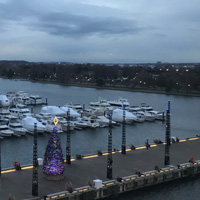NCR Organizational Development Class Explores the New District Wharf
December 21, 2017

Waterfront attractions have long been selling points for cities all over the United States. Chicago’s famous, bold skyscrapers tower over Lake Michigan; cafes and nightclubs dot the San Antonio Riverwalk; and folks flock to River Street in Savannah for its historic charm. So what sets the revitalized District Wharf apart from so many of America’s beloved waterfronts? Professor Linda Brown’s CHNG 5000 class, Practicing Change Management, had the opportunity to find out.
Organizational development is the newest graduate program offered at Webster campus locations in the National Capital Region, with classes starting less than a year ago. The National Capital Region encompasses several sites in the Washington metropolitan area including the new campus location, Joint Base Myer-Henderson Hall, located near the Pentagon. Webster also offers classes at Fort Belvoir, Joint Base Anacostia-Bolling, Joint Base Andrews NAF, and at the Southern Maryland Higher Education Center.
Brown’s course objectives are to introduce her students to advanced theories, skillsets, and interventions of change leadership and organizational development. “My students will learn about the latest approaches and best practices, and begin to experiment with interventions in their own organizations in this class,” said Brown. As a growing field, especially in the Washington area, the class explored the recently unveiled District Wharf to learn about how much organizational development and planning went into the massive project.
About the Trip
The class of five began the evening by touring the brand new Channel apartment homes, a mixed-income building that overlooks the Potomac River on one side and some of the nation’s most iconic monuments on the other. Offering studio, one-, and two-bedroom leases, the class learned the industrial-style building uses high efficiency lighting, low-flow plumbing fixtures, and that it even has a green roof to encourage its residents to adopt a more sustainable lifestyle. Plus, after viewing two sample units, the students got to see how the architects and designers were able to construct such high-functioning living spaces within a minimal amount of square footage. For example, studio units include a murphy bed in the living room, and all the units come with a moveable kitchen island. Floor-to-ceiling windows allow for ample natural sunlight, and a communal courtyard provides a pool, grills, cabanas, and a dog run for all residents.
The class then met with Elinor Bacon of ER Bacon Development, one of the partners of Hoffman Madison Waterfront, developer of The Wharf. Bacon showed the class the model of the overall project and outlined the history of the development, starting with the Anacostia Waterfront Initiative of Mayor Anthony Williams, and the Southwest Waterfront Master Plan developed by the D.C. Office of Planning and the National Capital Revitalization Corporation. She discussed the planning and redevelopment process, and how the work of Hoffman-Madison Waterfront, the development entity chosen by the District to redevelop the Southwest Waterfront – led by PN Hoffman and Madison Marquette, in partnership with the District and the community – resulted in The Wharf, Phase One. The Wharf officially opened in October, and now it is enjoyed by all. The class viewed the model of Phase Two of the development and Bacon explained that the Planned Unit Development for Phase Two was recently approved by the D.C. Zoning Commission, and that construction of Phase Two will begin in late 2018.
After walking around The Wharf, the class headed to Kith and Kin, an upscale restaurant with a Caribbean influence. Here, the class sat down for a discussion with Michael Shannon of D.C.’s Workforce Investment Council. Before joining the city government, Shannon was a construction workforce development consultant for Clark Construction, the major builder at The Wharf. Shannon’s work contributed to the D.C. Wharf project and maximized construction job and apprenticeship opportunities for D.C. residents. Shannon shared his viewpoints on the project’s construction in a Q&A session, explaining D.C.’s First Source Agreement, which requires that at least 51 percent of the new hires reside in the District. “This program helps people get employed who otherwise might not have been able to find employment,” he explained. “We hired on all levels of the trades.”
In addition to working on The Wharf project, Shannon is also the coordinator for D.C. United’s new soccer stadium. The stadium, just past The Wharf’s boundaries, is expected to be another great attraction for the area. “Once it’s open, we plan to host soccer clinics for our youth community, among other programs,” said Shannon. As a native Washingtonian, Shannon shared that his favorite part about working on The Wharf project is watching the development unfold. “It’s like watching a garden grow,” he said. “I remember when this was just a parking lot. Now we have hotels, restaurants, and piers. It’s its own community in a place that was hardly used in the past.”
Practicing Change Management and Organizational Development
Organization development, by definition, is the area of study where students and professionals learn to hone in on their skills, marketability, organizational tactics, and effectiveness in project management. With her students in the right course at the right time, Brown’s class got to experience organizational development in action. They got to learn firsthand about the 10-year Wharf project, from its official inception in 2007 to its opening weekend celebrations in Fall 2017.
Submitted by Allison Brooks
